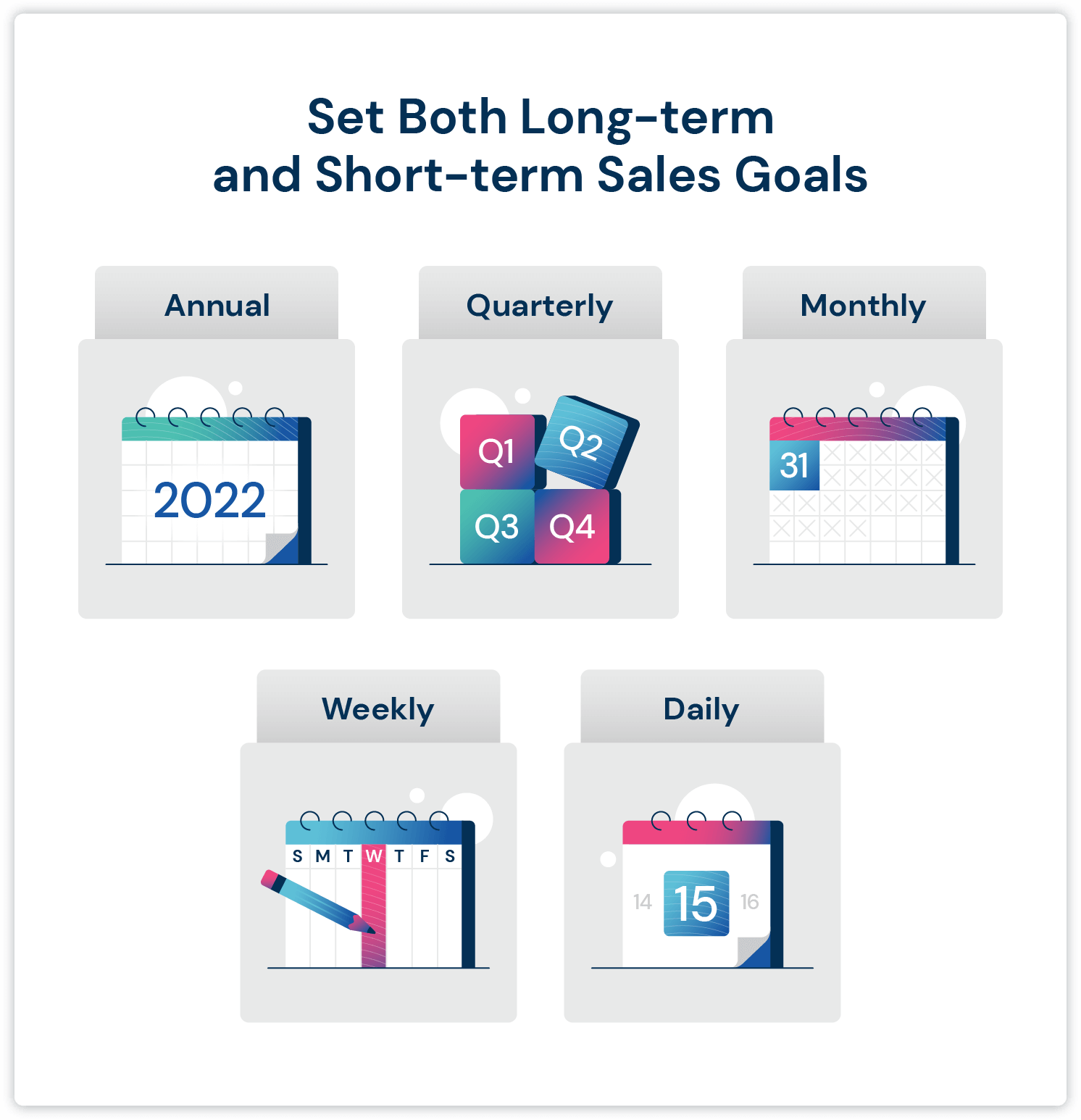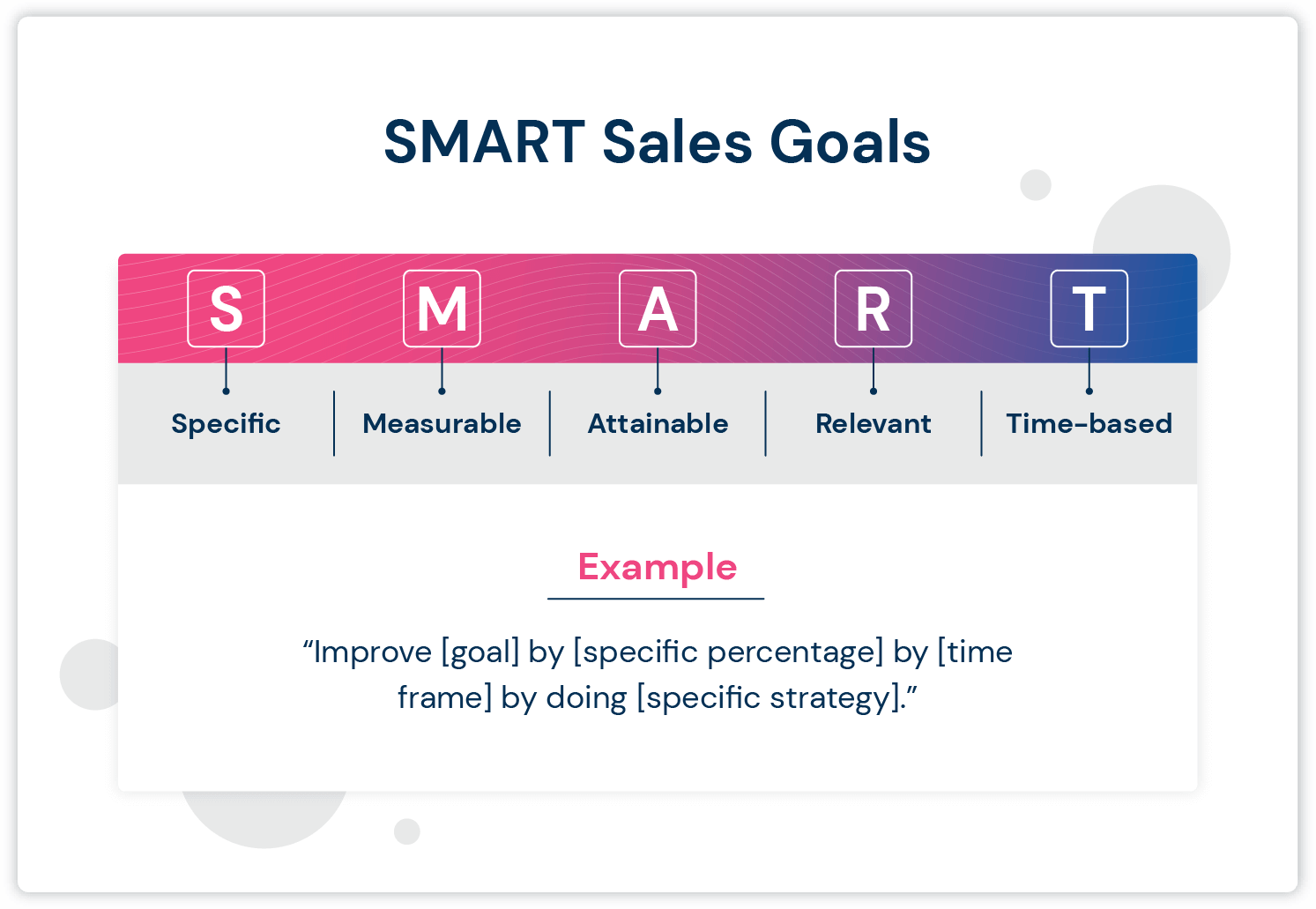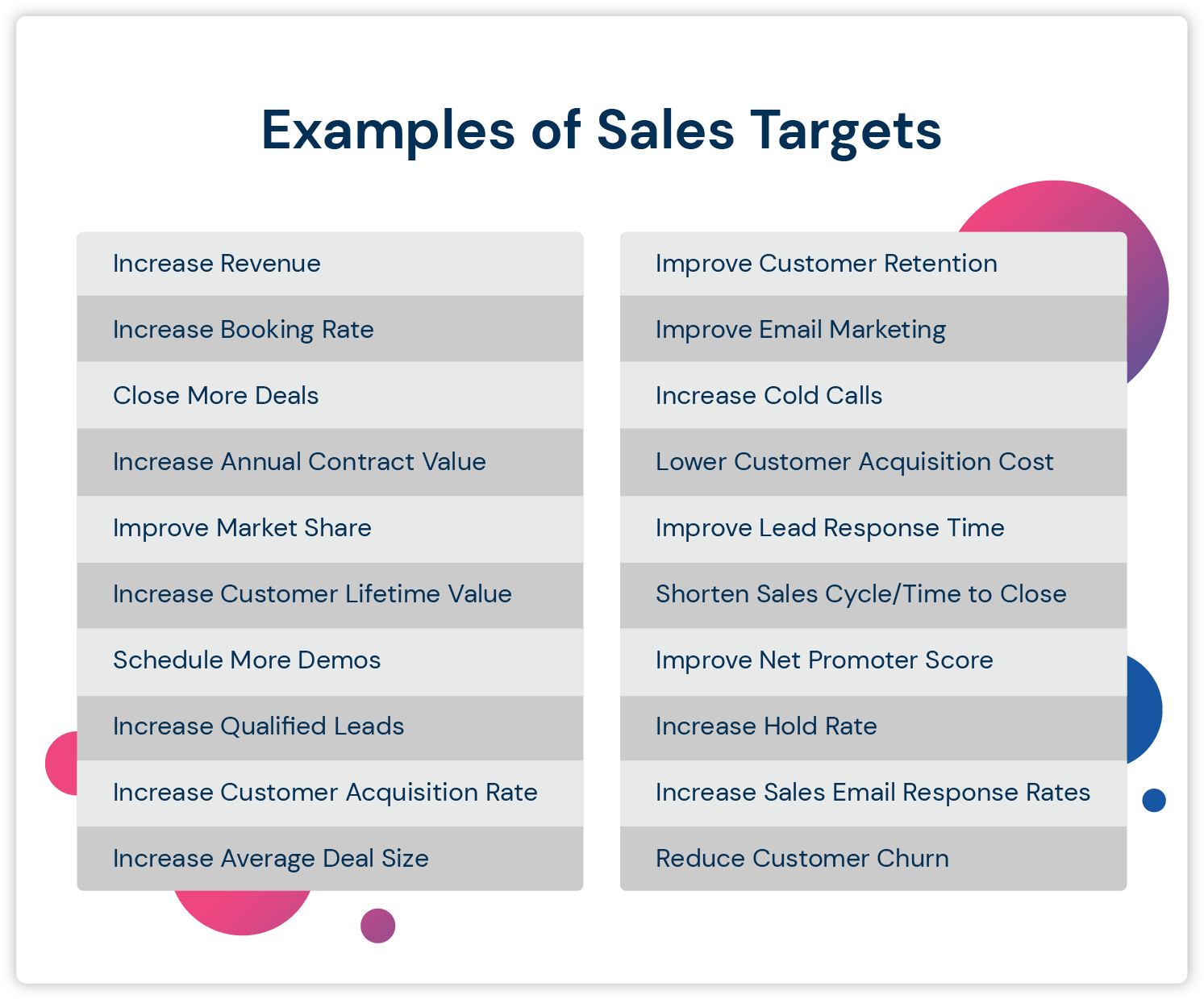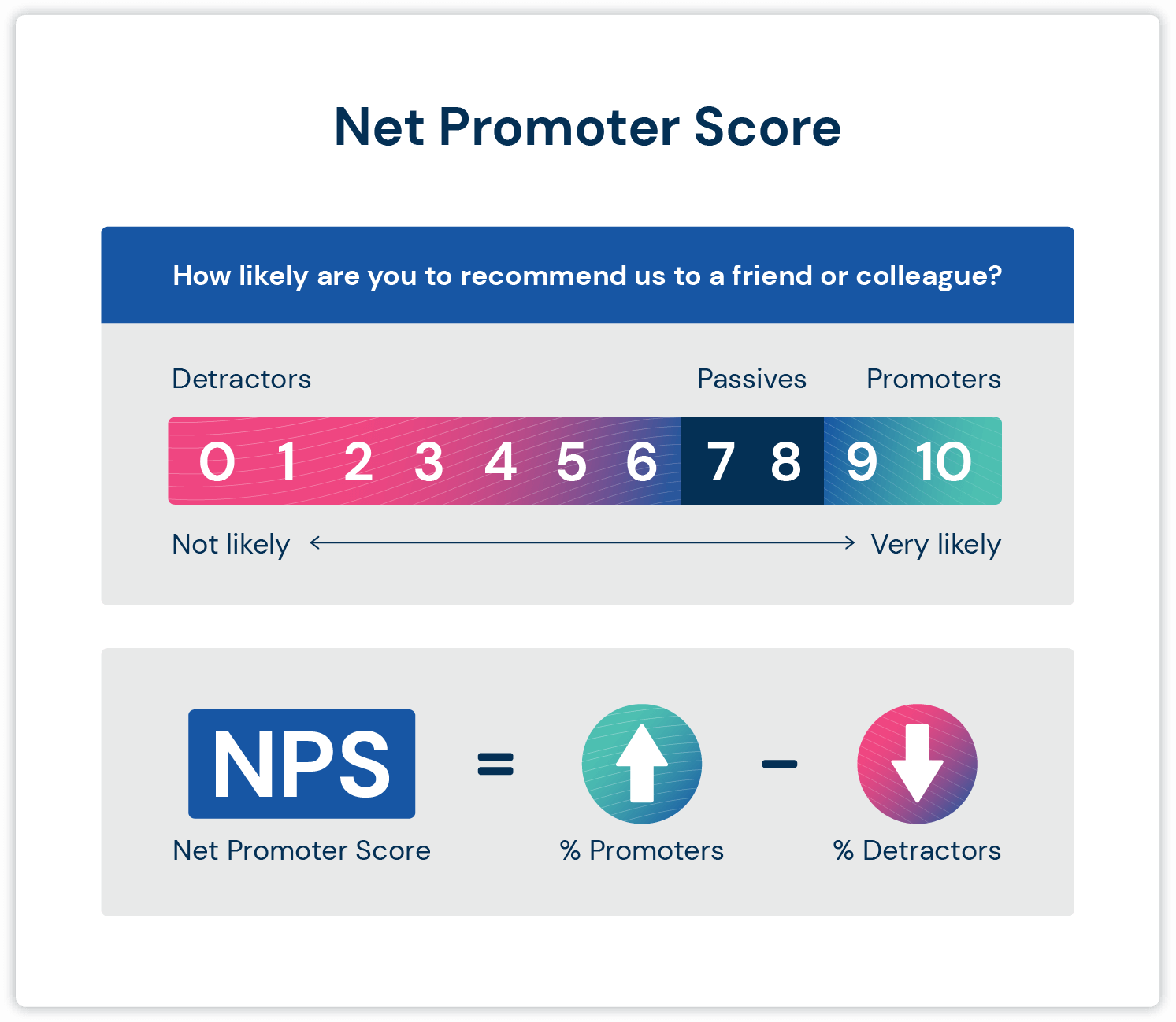19 Smart Sales Goals Examples for Your Team

Contents
As a leader, it’s imperative to set clear motivational sales goals for your team. Not only will goals fire up your team members to do their best work, but your business isn’t likely to grow without carefully considered, well-defined goals for both the short and long term.
What does a great sales goal look like? At Mailshake, we work with and support growing sales teams every day, so we’ve compiled a list of 19 sales goals examples. We’ll also cover a refresher on SMART goal setting, the importance of each type of goal and what it takes to achieve them.
What Are Sales Goals?
Sales goals are objectives to help you improve performance across your team. They are tied to specific business goals and sales KPIs. They may be revenue-related, tied to customer acquisition or other areas. These goals may be set by a collaboration between leadership, the finance team and sales management. Then it’s up to the sales team to work toward those goals.
Why Do You Need Sales Goals?
Your team needs both long-term and short-term, broader scope and smaller scope goals to succeed and improve. It’s important that these goals are specific enough to put the whole team on the same page while still being realistic. To incentivize the team, a combination of long-term and short-term goals that can be met and rewarded frequently is usually a smart move.

If it makes sense for your team, you can also set stretch goals. Stretch goals go beyond your regular goals to motivate and push your team even further to do their best work. A stretch goal usually makes sense if your team is already exceeding its regular goals.
What’s the secret to successful sales goals? Setting SMART goals is one way to make your goals more effective.
How To Set SMART Sales Goals
A SMART goal uses the criteria of specific, measurable, attainable, relevant and time-based to provide clarity and guidance around the objective.
Here’s each element of a SMART goal explained:

- Specific: Clearly articulate the goal and pinpoint a specific strategy you plan to implement to reach the goal.
- Measurable: Attach numbers to your goal so you have a way to measure it. Instead of saying you generally want to increase revenue, say definitively that you want to increase revenue by 10% in the next year. Then, set up your sales software like CRM and sales dashboard to help keep you on track toward the goal.
- Attainable: Look at last year’s performance to inform your goals for this year. Keep your goal realistic given your specific team, business and current capabilities.
- Relevant: Align your sales objectives with overarching business goals and company values.
- Time-based: Give your goals a monthly, quarterly or yearly time limit so that you can see the finish line and work confidently toward it.
Another way you can phrase a SMART goal is as follows:
Improve [goal] by [specific percentage] by [time frame] by doing [specific strategy].
19 Sales Goals Examples
Here’s a look at different examples of sales goals and how teams may approach them.

1. Increase Revenue
- Type of goal: Large scale
- Example: Increase MoM revenue by 15%
Revenue targets are all-important sales goals that most companies will have in place. You can set monthly, quarterly or annual sales revenue goals. While your team may have an overarching goal, breaking it down into smaller goals for individual reps can also help keep everyone on track.
2. Increase Booking Rate
- Type of goal: Activity
- Example: Increase booking rate by 50% next quarter by minimizing lead response time
The booking rate is important to help turn leads into customers. Focusing on booking successful meetings can help increase conversion rates. Do this by focusing on qualifying leads and optimizing your sales email invites.
3. Close More Deals
- Type of goal: Large scale
- Example: Close 20 deals each month/sales rep in Q1
To close more deals and increase profit margins, you can focus on both team and individual goals. You may need to focus on qualifying leads or better utilizing your CRM system; the right strategy will be tailored to your team’s specific needs. One example is allowing your sales team to chase more leads by taking some menial tasks off their plate through email automation or something similar.
4. Increase Annual Contract Value
- Type of goal: Large scale
- Example: Increase ACV to $5,000 per sales representative by the end of the year
ACV is the average revenue generated from a customer contract in one year. This is helpful especially if customers are on a subscription model to determine the average value from that customer in a year.
5. Improve Market Share
- Type of goal: Large scale
- Example: Achieve a market share of 20% in the next two years for [product]
Capturing market share is a goal shared by startups and large enterprises alike. Focusing on sales and increasing revenue can help your business gain a larger percentage of the market.
6. Increase Customer Lifetime Value
- Type of goal: Large scale
- Example: Increase CLV to $100,000 in the next two quarters by identifying upselling and cross-selling opportunities
Customer lifetime value (CLV) helps predict the amount of revenue a business will generate during the entire relationship with one customer. You can increase CLV by focusing on customer retention and increasing spending. It’s much easier to make money from an existing customer than to obtain a new one — for example, your team can focus on getting customers to upgrade their current deals.
7. Schedule More Demos
- Type of goal: Productivity
- Example: Schedule 15 demo meetings per week by optimizing email CTAs
Aimed at sales development representatives (SDRs), this individual goal of scheduling more demos will help maintain activity in your sales pipeline.
8. Increase Qualified Leads
- Type of goal: Large scale
- Example: Increase monthly qualified leads by 20% by increasing prospecting time
Increasing your number of qualified leads will keep your sales pipeline healthy and improve your chances of closing deals and increasing customer lifetime value. You can create goals for your sales reps around time spent prospecting and use sales tools that can help them nurture leads more effectively.
9. Increase Customer Acquisition Rate
- Type of goal: Large scale
- Example: Increase customer acquisition rate by 15%
Gaining new customers is another common sales goal that may help your business stay competitive. You can improve your customer acquisition strategy in a number of ways, such as improving content marketing, targeted advertising and asking for referrals.
10. Increase Average Deal Size
- Type of goal: Large scale
- Example: Increase average deal size by $500 by next year
You can set a goal for your team to increase average deal size and increase order value. There are different ways you can go about this, such as improving your upselling and cross-selling efforts or finding ways to incentivize bigger purchases.
11. Improve Customer Retention
- Type of goal: Large scale
- Example: Decrease churn rate by 15% by the end of the year
Reduce customer churn by setting a specific goal for your sales team. This could look like focusing on incentives, engaging with existing customers and improving lead-qualifying strategies. You can also work with your product development team to ensure you have a clear understanding of why account churn may occur and why specific products may not be a fit for certain customers. That way, you can better target customers who have a need for your product.
12. Improve Email Marketing
- Type of goal: Large scale
- Example: Improve click-through rate by 5% by personalizing all emails
You can improve your email marketing strategy by personalizing your emails, segmenting your email list based on behavior, optimizing subject lines, optimizing for mobile and creating more dynamic content for your emails.
13. Increase Cold Calls
- Type of goal: Productivity
- Example: Make 35 cold calls each day
Create a goal to make a specific number of cold calls each day or week. To help motivate your team, set an incentive like a bonus or gift card or set up a sales contest for their outreach efforts. To open up time on their schedules, you can also set up sales automation tools to take care of smaller time-consuming tasks.
14. Lower Customer Acquisition Cost
- Type of goal: Large scale
- Example: Reduce customer acquisition cost by 5% by targeting easier-to-reach prospects
Customer acquisition cost (CAC) is the total cost required to obtain a new customer. To decrease this cost, you can find ways to better target your audience, improve customer retention and improve the sales funnel. You should examine where you are spending the most in the sales process and evaluate if you are targeting too many difficult-to-reach prospects. You can also find out which marketing channels your most valuable leads are coming from and focus on those.
15. Improve Lead Response Time
- Type of goal: Productivity
- Example: Respond to warm leads within five hours of receiving a call, message or email
There are a number of reasons why sales reps may not respond to messages from leads right away, like having little time and losing track of messages. To improve lead response times and ensure potential customers’ emails aren’t left unanswered, set a goal for your team on response times and work with them to make it possible.
16. Shorten Sales Cycle/Time to Close
- Type of goal: Productivity
- Example: Shorten time to close by 10%
Shortening the time to close will help your team close more deals quicker. You will first need to know how long your sales cycle is. Then, identifying inefficiencies in the sales cycle can help you choose where to focus your efforts on improving efficiency.
17. Improve Net Promoter Score
- Type of goal: Large scale
- Example: Increase promoters by 10%
A net promoter score (NPS) is an indicator of customer satisfaction. An NPS survey, like the one below, asks people how likely they are to recommend your company to others. You can aim to increase your number of promoters or decrease detractors by improving the quality of your customer service.

18. Increase Hold Rate
- Type of goal: Productivity
- Example: Increase hold rate by 30% by setting the meeting within two days and automating reminders
Hold rate, or show rate, is your demo-booked-to-demo-attended ratio. Booking meetings with prospective leads is essential, but you need to make sure that those meetings are actually attended. You can focus on tactics like having sales reps set the meeting quickly, suggest times instead of leaving it up to the prospective lead and scheduling email reminders before the meeting starts.
19. Increase Sales Email Response Rates
- Type of goal: Productivity
- Example: Improve response rates by 20% by optimizing subject lines
Goals around sales prospecting like email response rates are important. You can set a goal for email responses to identify salespeople who need more training on prospecting or perhaps improve your outreach strategy. Ways to increase your open and response rates include optimizing your subject lines, personalizing emails and writing effective follow-ups.
How To Achieve Your Sales Goals
Here are some tips to set goals, make a plan and track your team’s progress.
Set goals for individuals as well as overall teams. Base targets on data from the previous time period, then make an action plan.
Track your performance. Use your CRM or sales engagement platform to track your KPIs and monitor your team’s progress.
It’s a tricky balance between setting ambitious goals and keeping your team’s capacity in mind. You don’t want to overwhelm your team with too many lofty goals at once. But by setting well-thought-out SMART sales goals and putting an action plan in place, you’ll identify goals that your team feels confident in and can strive for.
Now that you’ve read through multiple sales goals examples, take the next step toward reaching your sales targets with Mailshake. Connect with more prospects, book more meetings and generate more sales with our simple yet powerful sales engagement platform.
Sales Goals Frequently Asked Questions (FAQs)
How Do I Set Realistic and Achievable Sales Goals?
To set realistic and achievable sales goals, ensure that all your goals are in accordance with the SMART goal-setting framework.
It’s also very important that you have reasonable expectations from your sales team and that all the goals are in line with their skills and capabilities.
What Are SMART Goals in a Sales Team?
SMART goals refer to specific, measurable, attainable, relevant, and time-based objectives that a team sets to achieve their business goals.
A SMART goal for a sales team could be, for example, closing 20% more deals in the next six months by improving the quality of leads and developing better sales proposals.
What Metrics and KPIs Should I Consider When Setting Sales Goals?
Some commonly used metrics by sales teams are number of leads generated, new customer acquisition rate, customer onboarding time, and revenue per transaction.
You can also track KPIs such as close rate, average deal size, win rate percentage, and customer satisfaction score while setting sales goals.
How Often Should I Review and Revise My Sales Goals?
You should review and revise your sales goals once per quarter. This ensures that all your objectives are still attainable and realistic in light of any new developments or changes.
What Are the Best Tools to Help Me Achieve My Sales Goals?
There are many tools out in the market that can help you achieve your sales goals. For example, a sales engagement platform like Mailshake can help you generate more leads and convert them.
Similarly, a Customer Relationship Management (CRM) system such as Hubspot can help monitor and measure progress, while Asana or other team communication tools can facilitate collaboration between team members.





